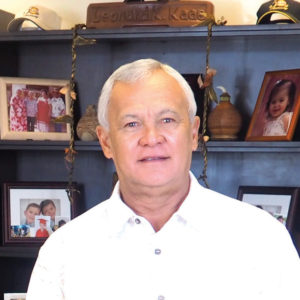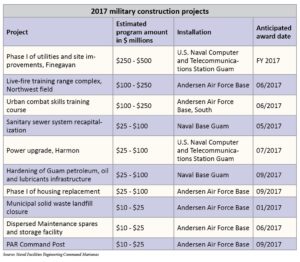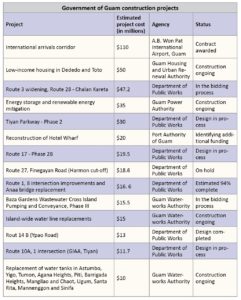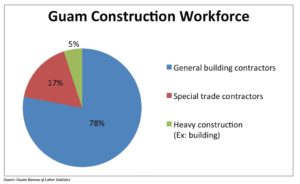By Joy White
Guam construction companies ride the ebb and flow of work in the private, local government and military sectors to sustain an industry that is vital to the island’s economy and growth.
Private sector and local government
“The local industry is in a positive mode at the present time. There continues to be private investment in concert with the military’s future realignment,” says Leonard K. Kaae, senior vice president and general manager of Black Construction Corp.
Much of the private investment in construction is fueled by the growth in the tourism industry and includes the revitalization or expansion of existing facilities, as well as investment in new projects, Kaae says.
Black Construction has completed several projects within the past year in Guam and Saipan, including the construction of Comfort Homes in Saipan; Matson’s headquarters in Anigua; the foundation piles of Tsubaki Hotel; and work on the closure of Saipan’s Puerto Rico Dump.
Black Construction acquired $173 million in 2017 in backlog with five new project awards, including the international arrivals corridor of A.B. Won Pat International Airport, Guam, estimated at $96.9 million and upgrades to Diego Garcia’s wharf refueling facility.
Core Tech Development LLC, the real estate development division of Core Tech International, has several commercial development and housing projects in the pipeline, including the second phase of Summer Towers in Tamuning and the construction of 16 cliff-line villas on the same property; the construction of Summer Town Estates III, which will provide 66 low-income housing units; and a housing development in Ukudu, Dededo featuring 555 housing units, says Ho S. Eun, founder and president of Core Tech International Corp.
The company also has plans to build a parking structure for its recent acquisitions, Bayview Hotel and Ocean View Hotel in Tumon.
Smithbridge Guam Inc. has been active with operating its quarry and with minor government of Guam projects.
“The quarry has been very busy all the way through. We supply most of the large contractors on island with specific and specialized aggregates,” says Stevyn J. Radonich, vice president of Smithbridge Guam.
After being for sale for 18 months and having nearly been sold twice, the company has officially been off the market since July, Radonich says. This has created stability in the company and among its employees. Smithbridge’s ongoing projects include work on the Bile and Pigua Bridges for the Department of Public Works and small projects at the Port Authority of Guam, as well as private sector work in the NMI.
Smithbridge is considering projects with Guam Power Authority and Guam Waterworks Authority, as well as work elsewhere in the region, such as Diego Garcia and the Marshall Islands.
Military contracts
Following a slump in military contracts in the middle of the year, industry experts expect this will pick up by the fourth quarter.
Naval Facilities Engineering Command Pacific is projected to release requests for proposal for military aid to the civil community, or MACCs, in the fourth quarter of this year, according to a February update provided by Capt. Stephanie Jones, Naval Facilities Engineering Command Marianas commanding officer. The capacity for the projects is $990 million.
Anticipated projects under NAVFAC’s Defense Police Review Initiative include cantonment utilities and site improvements estimated at $250 million to $500 million; the live-fire training range complex estimated at $50 million to $100 million; and the urban combat training project estimated at $100 million to $250 million.
Funds for the demolition and replacement of housing family housing on Andersen Air Force Base are expected to be awarded in September. In response to the April RFP for this project, Black Construction Corp., Hensel Phelps and Contrack Watts Inc. issued sub-bids for the project in May.
Other special projects to be awarded this year include repairs to heavy weather mooring at Alpha Wharf at Naval Base Guam with an estimated program amount of $1 million to $5 million; and taxiway circuits at Andersen Air Force Base estimated at $10 million to $25 million. The anticipated award date for these projects is September.
Jerrold C. Johnson, president of Hawaiian Rock Products, speaking at a Guam Workforce Development Board meeting on July 26, says there is a backlog in military projects.
“Some projects are two years behind and they really haven’t started the projects. […] I think over the last month [July] there has probably been $500 million to $600 million of work that hasn’t been awarded yet, but that amount of work has been bid over the last few months,” he says.
Many in the industry are impacted by the delays.
“[Core Tech] has bid for many military projects, but the military has not awarded any of the contracts,” Eun says.
Radonich says a prospective dredging contract for Smithbridge has been pending for two years, and although the company has bid on other projects, such as the Urban Combat Training Facility, live-firing range and work at Finegayan and Potts Junction, none of the contracts have been awarded.
Military permitting and Munitions and Explosive Concerns and unexploded ordinance inspections have slowed down progress, for two or three years in some cases, Radonich says. Progress on the project for the firing range has been halted due to environmental concerns.
Smithbridge does have minor military work, including the demolition and replacement of the roof of a fuel tank; a subcontract with P&S Construction; various demolition projects on Andersen Air Force Base; and the replacement of a fuel tank in Sasa Valley, but Radonich predicts the industry will slow down through September.
“We’re in a bit of a lean period because of these delays,” Radonich says.
When the ball does get rolling on federal government plans, Kaae says he is confident Black Construction and the construction industry is positioned to take advantage of the opportunities.
“[…] we look forward to the federal government award some of the pending projects. I’m forecasting another boom in the construction industry,” he says.
Workforce issues
Once the delay in military contract awards is over, Guam will be faced with the issue of workforce shortage caused by denials of H-2B visas that some see could be a major detriment to the construction industry.
Most of Guam’s H-2 foreign workers were in the construction industry and accounted for about 17 % of the industry labor force, according the Department of Labor Bureau of Labor Statistics.
Since January 2016, U.S. Citizenship and Immigration Service denied all H-2B visas applications for Guam, including renewals of visas that had been granted for several years prior.
So far the projects worked on by local construction companies are for roads and infrastructure, which require a different type of worker than the larger military works, Johnson says. Yet there is still a need for carpenters and cement masons for these projects.
“[The big military projects] haven’t really started and [companies] haven’t had the need for the labor, […] but there will be an increased need for two types of work: one that can build buildings and one that can build roads and sewer lines and water lines and construction types,” he says.
Core Tech is severely impacted by the H-2B visa issue. H-2B workers make up about 45% of Core Tech’s workforce. The company repatriated 388 workers starting Sept. 4, 2016 due to the denial of all of the company’s applications for H-2B visa renewals.
The visa issue also has broader implications, Eun says, such as its impact on real estate costs and cash flow to the government, as companies employing foreign labor must pay taxes for their employees.
“[The denial of] H-2B is a big issue,” he says. “It doesn’t end with the construction industry. It effects the general population, such as homebuyers.”
Residents planning to build homes can expect to see an increase of at least 40% to 60% as labor costs increase and are passed on to home buyers, Eun says. In addition, because the inventory of homes remains the same while the demand for homes continues to increase, the value and price of the homes increases.
The visa issue is also impacting vendors because construction companies have stopped purchasing materials. Many small construction companies have closed shop because “they couldn’t handle the contingency,” he says.
“If it was a changing situation that we saw beforehand, we could [have] adapted,” Eun says. “However, it was sudden. There were no precautions taken.”
To address the issue, the company attempted to train workers in-house. However, after three months construction did not progress.
It was a learning experience for the company. “H-2B was the secret,” Eun says.
With Summer Towers, the company is losing $400,000 per month in potential rental revenue because construction has been slowed.
Construction companies that rely on H-2B workers are in a “dark tunnel,” he says, as no one knows when, or if, the situation will improve.
A lawsuit filed on Oct. 4 against USCIS continues in the District Court of Guam. The suit was denied class certification to have H-2B applications approved, yet aims for the court to order USCIS to engage in rule-making procedures with notice and comment so petitioners can have reasonable expectations of how future H-2B applications will be treated.
Other construction companies seem unperturbed and put their faith in a local workforce.
Black Construction’s workforce of 357 is locally-hired. Black Construction has not had the need to supplement its workforce with foreign labor since 1992, and the foreign workers returned to their countries by 1993, Kaae says.
“It’s fortunate for the Black Group to have retained a local workforce over the years, allowing Black to undertake critical work. This ability allowed us to avoid unnecessary delays on projects,” he says.
Sustaining a workforce is not an issue for Smithbridge, either, which has a workforce of 104 local employees.
“The H-2B issue does not affect us,” Radonich says. The company has hired only a handful of H-2B workers over the past decade for temporary work, on a need-only basis.
In any case, the construction industry is poised for growth.
An economic outlook report for fiscal 2018 prepared by Chief Economist of the Department of Labor Gary Hiles, says that historical precedence shows that the construction industry can be expected to continue to be a major influence on the Guam economy.
“The growth in Guam’s economy has been, and is expected to continue to be, driven by a combination of private and public investment in construction for the civilian and defense sectors,” the report says.
The first of four Summer Towers buildings came on to the rental market on May 18 to meet the need for real estate inventory. However, Core Tech International has been forced to slow the construction of the remaining three towers due to a workforce shortage, a challenge many in the construction industry face.
Photo by Jackie Hanson























